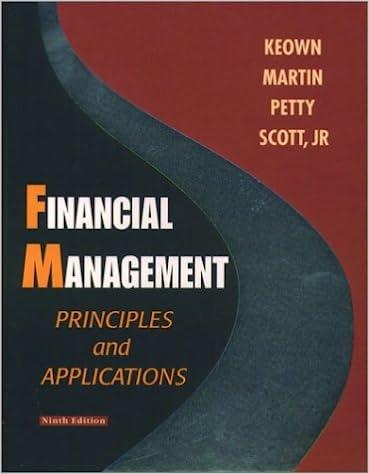Question
PLEASE HELP FILL IN THE BLANKS. SCENARIO DETAILS BELOW The existing plant has excess capacity, in a fully depreciated building, to install and run the
PLEASE HELP FILL IN THE BLANKS. SCENARIO DETAILS BELOW 
| The existing plant has excess capacity, in a fully depreciated building, to install and run the new equipment to produce the new Designer Eyewear line. Due to relatively rapid advances in technology, the project was expected to be discontinued in four years. The new project was expected to sell for $ 79 per unit and had projected sales of 4600 units in the first year, with a projected (Most-Likely scenario) 17.0 % growth rate per year for subsequent years. A total investment of $ 872,000 for new equipment was required. The equipment had fixed maintenance contracts of $ 310,096 per year with a salvage value of $ 172,629 and variable costs were 13 % of revenues. The company also needed to consider both the Best-Case and Worst-Case scenarios in the analysis with growth rates of 27.00 % and 1.70 % respectively. |
| The new equipment would be depreciated to zero using straight line depreciation. The new project required an increase in working capital of $ 197,890 and $ 31,662 of this increase would be offset with accounts payable. The company currently has 966000 shares of stock outstanding at a current price of $ 65.00. Even though the company has outstanding stock, it is not publicly traded and therefore there is no publicly available financial information. However, after analysis management believes that its equity beta is 0.88. |
| The company also has 117000 bonds outstanding, with a current price of $ 1,090.00. The bonds pay interest semi-annually at a coupon rate of 7.40 %. The bonds have a par value of $1,000 and will mature in 7 years. The average corporate tax rate was 35 %. Management believes the S&P 500 is a reasonable proxy for the market portfolio. Therefore, the cost of equity is calculated using the company's equity beta and the market risk premium based on the S&P 500 annual expected rate of return - Sundar would calculate the monthly expected market return using 5 years of past monthly price data available in the worksheet Marketdata. This would then be multiplied by 12 to estimate the annual expected rate. Sundar remembered that if the expected rate of return for the market was too low, too high, or negative, a forward looking rate of an historical average of about 9.5% would have to be used, as the calculated value for the current 5-year period may not be representative of the future. Sundar would consider a E(Rm) between 8-12% acceptable. Sundar would calculate the market risk premium: E(Rm) - Rf from the previous calculations using the risk-free rate data available in the worksheet Marketdata. Sundar noted that the risk-free rate was on an annual basis. Sundar needed to calculate the rate at which the project would have to be discounted to calculate the Net Present Value (NPV) of the proposed project based on the decision of raising capital and the current capital market environment. This discount rate, the WACC, would obviously influence the NPV and could affect the decision of whether to accept or reject the project. Thankfully, all the information needed to calculate this was available. Sundar needed to clearly show all the calculations and sources for all parameter estimates used in the calculation of the WACC (and ultimately the NPV). Gathering all the available information, Sundar got a large cup of extra strong coffee and sat down to work on the development of the Capital Budgeting project model. The correct recommendation to the board was critical to the future growth of the firm! |
Step by Step Solution
There are 3 Steps involved in it
Step: 1

Get Instant Access to Expert-Tailored Solutions
See step-by-step solutions with expert insights and AI powered tools for academic success
Step: 2

Step: 3

Ace Your Homework with AI
Get the answers you need in no time with our AI-driven, step-by-step assistance
Get Started


